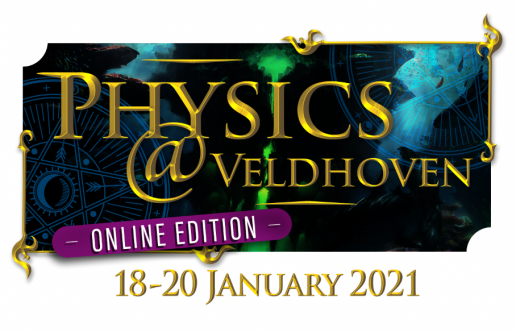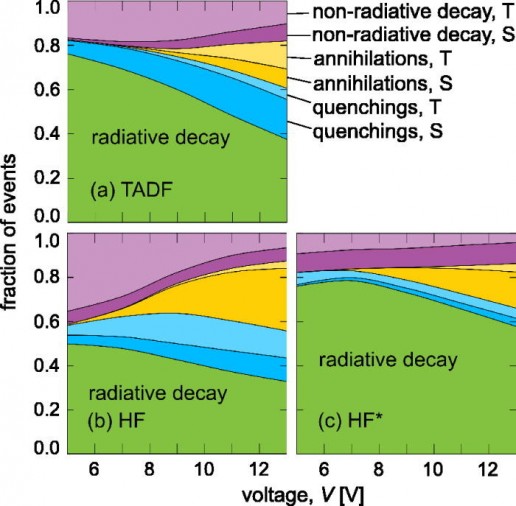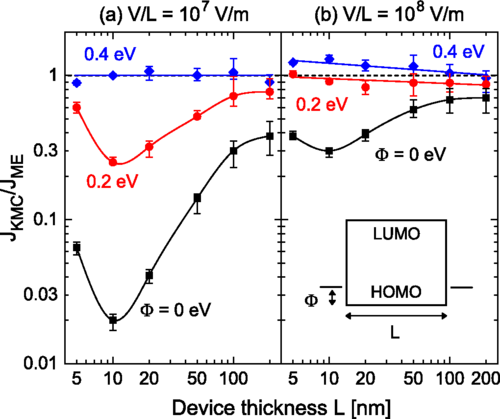Physics@Veldhoven 2021
Simbeyond will take part in the 2021 edition of Physics@Veldhoven congress. Young researchers will be given the chance to present themselves and their work alongside renowned names from the Dutch and international physics community.
For update information check: https://www.nwo.nl/en/meetings/physicsveldhoven
CES 2021
Simbeyond will take part part to the Dutch Mission to the Consumer Electronics Summit (CES) 2021 as an exhibitor. During this virtual event you will be able to demo our products and talk to our experts about advanced OLED simulations.
For update information check https://www.ces.tech/About-CES.aspx
Efficiency loss processes in hyperfluorescent OLEDs: A kinetic Monte Carlo study
Efficiency loss processes in hyperfluorescent OLEDs: A kinetic Monte Carlo study
S. Gottardi, M. Barbry, R. Coehoorn, and H. van Eersel
In hyperfluorescent OLEDs, fluorescence emitter molecules are sensitized by molecules utilizing thermally activated delayed fluorescence (TADF). In principle, obtaining an internal quantum efficiency (IQE) approaching 100% combined with a small IQE roll-off should be feasible. However, the actual device performance depends on the balance between the transfer of singlet and triplet excitons from the TADF emitters to the fluorescent molecules and on the role of excitonic loss processes. Here, we study these factors governing the IQE using kinetic Monte Carlo simulations, for prototypical OLEDs based on the green TADF emitter (2s,4r,6s)-2,4,5,6-tetrakis(3,6-dimethyl-9H-carbazol-9-yl)isophthalonitrile (4CzIPN-Me) and the yellow fluorescent emitter 2,8-di-tert-butyl-5,11-bis(4-tert-butylphenyl)-6,12-diphenyltetracene. Making use of the experimental photophysical interaction rates, the simulated voltage versus current density characteristics and IQE roll-off agree well with experiment. The simulations show that the IQE can be enhanced by carefully avoiding the formation of charge-transfer excitons.
Powered by: Bumblebee
Effect of exciton diffusion on the triplet-triplet annihilation rate in organic semiconductor host-guest systems
Effect of exciton diffusion on the triplet-triplet annihilation rate in organic semiconductor host-guest systems
R. Coehoorn, P. A. Bobbert, and H. van Eersel
Phys. Rev. B 99, 024201 (2019)
We study the contribution of triplet exciton diffusion to the efficiency loss resulting from Förster-type triplet-triplet annihilation (TTA) in organic phosphorescent semiconductor host-guest systems, using kinetic Monte Carlo (KMC) simulations. Our study focusses on diffusion due to Förster-type guest-guest transfer, but includes also a comparison with simulation results for the case of Dexter-type guest-guest transfer. The simulations are carried out for a wide range of Förster radii, and for guest concentrations up to 100 mol%, with the purpose to support analyses of time-resolved photoluminescence experiments probing TTA. We find that the relative contribution of diffusion to the TTA-induced efficiency loss may be deduced quite accurately from a quantitative experimental measure for the shape of the time-dependent photoluminescence intensity, the so-called r ratio. For small guest concentrations and Förster radii that are most relevant to organic light-emitting diodes (OLEDs), the diffusion contribution is in general quite small. Under these weak-diffusion conditions, the absolute diffusion contribution to the TTA-induced efficiency loss can be understood quantitatively using a capture radius formalism. The effective guest-guest diffusion coefficient that follows from the TTA simulations, using the capture radius formalism, agrees well with the diffusion coefficient that follows from direct KMC diffusion simulations. The simulations reveal that the diffusion coefficient is strongly affected by the randomness of the distribution of guest molecule locations.
Powered by: Bumblebee
Effect of Coulomb correlation on charge transport
Effect of Coulomb correlation on charge transport in disordered organic semiconductors
F. Liu, H. van Eersel, B. Xu, J. G. E. Wilbers, M. P. de Jong, W. G. van der Wiel, P. A. Bobbert, and R. Coehoorn
Phys. Rev. B 96, 205203 (2017)
Charge transport in disordered organic semiconductors, which is governed by incoherent hopping between localized molecular states, is frequently studied using a mean-field approach. However, such an approach only considers the time-averaged occupation of sites and neglects the correlation effect resulting from the Coulomb interaction between charge carriers. Here, we study the charge transport in unipolar organic devices using kinetic Monte Carlo simulations and show that the effect of Coulomb correlation is already important when the charge-carrier concentration is above 10−3 per molecular site and the electric field is smaller than 108 V/m. The mean-field approach is then no longer valid, and neglecting the effect can result in significant errors in device modeling. This finding is supported by experimental current density-voltage characteristics of ultrathin sandwich-type unipolar poly(3-hexylthiophene) (P3HT) devices, where high carrier concentrations are reached.
Powered by: Bumblebee
Effect of polaron diffusion in disordered organic semiconductors
Effect of polaron diffusion on exciton-polaron quenching in disordered organic semiconductors
R. Coehoorn, L. Zhang, P.A. Bobbert, and H. van Eersel
Phys. Rev. B 95, 134202 (2017)
Exciton-polaron quenching (EPQ) is a major efficiency loss process in organic optoelectronic devices, in particular at high excitation densities. Within commonly used models, the rate is assumed to be given by the product of the exciton density, the polaron density, and a constant EPQ rate coefficient, which is proportional to the polaron diffusion coefficient and an EPQ capture radius. In this work, we study the effects of polaron diffusion on the EPQ rate in energetically disordered materials with a Gaussian density of states using kinetic Monte Carlo simulations, and show that the effective rate coefficient can depend strongly on the polaron concentration and on the electric field. We furthermore find that under realistic conditions, the effective value of the capture radius can exceed the expected value of ∼1 nm by up to two orders of magnitude. To a first approximation, the simulation results can be understood from macroscopic diffusion theory, adapted at finite electric fields to include the observed “polaron wind” effect. However, for strongly disordered systems we find distinct deviations from that theory, related to the very small time and spatial scales involved in the capture process.
Powered by: Bumblebee
Förster-type triplet-polaron quenching in disordered organic semiconductors
Förster-type triplet-polaron quenching in disordered organic semiconductors
R. Coehoorn, P.A. Bobbert, and H. van Eersel
Phys. Rev. B 96, 184203 (2017)
Triplet-polaron quenching (TPQ) is a major cause of the efficiency loss at large current densities in phosphorescent organic light-emitting diodes. The nature of the interaction process is presently not well understood. In this paper, we study TPQ due to Förster-type triplet-polaron interactions in energetically disordered organic semiconductors with a Gaussian polaron density of states. A continuum theory, which neglects the spatial inhomogeneity and energetic disorder, is from a kinetic Monte Carlo approach shown to correctly predict that the effective steady-state TPQ rate coefficient k_TPQ,eff depends only sensitively on the polaron diffusion in a rather narrow range of diffusion coefficients. However, in this regime, significant discrepancies between the two approaches are found, in particular for realistic values of the TPQ-Förster radius, around 3 nm, and for systems with strong energetic disorder. Both approaches show that k_TPQ,eff is not constant but can depend on the polaron density and the electric field. Various methods for deducing the TPQ mechanism from experiment are discussed, including an approach which utilizes the shape of the time-dependent photoluminescence after pulsed illumination.
Powered by: Bumblebee





